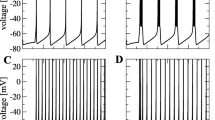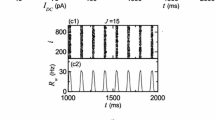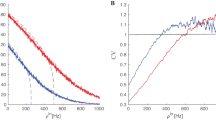Abstract
Behavior of a network of neurons is closely tied to the properties of the individual neurons. We study this relationship in models of layer II stellate cells (SCs) of the medial entorhinal cortex. SCs are thought to contribute to the mammalian theta rhythm (4–12 Hz), and are notable for the slow ionic conductances that constrain them to fire at rates within this frequency range. We apply “spike time response” (STR) methods, in which the effects of synaptic perturbations on the timing of subsequent spikes are used to predict how these neurons may synchronize at theta frequencies. Predictions from STR methods are verified using network simulations. Slow conductances often make small inputs “effectively large”; we suggest that this is due to reduced attractiveness or stability of the spiking limit cycle. When inputs are (effectively) large, changes in firing times depend nonlinearly on synaptic strength. One consequence of nonlinearityis to make a periodically firing model skip one or more beats, often leading to the elimination of the anti-synchronous state in bistable models. Biologically realistic membrane noise makes such “cycle skipping” more prevalent, and thus can eradicate bistability. Membrane noise also supports “sparse synchrony,” a phenomenon in which subthreshold behavior is uncorrelated, but there are brief periods of synchronous spiking.
Similar content being viewed by others

References
Acker CD, Kopell N, White JA (2001) Synchronization of strongly coupled excitatory neurons: Relating biophysics to network behavior. In: Fifth International Conference on Cognitive and Neural Systems. Boston, MA.
Alligood K, Sauer T, Yorke J (1997) Chaos-an introduction to dynamical systems. Springer-Verlag, New York.
Alonso A, Klink R (1993) Differential electroresponsiveness of stellate and pyramidal-like cells of medial entorhinal cortex layer II. J. Neurophysiol. 70: 128-143.
Alonso A, Llinás RR (1989) Subthreshold Na+-dependent theta-like rhythmicity in stellate cells of entorhinal cortex layer II. Nature 342: 175-177.
Canavier CC, Butera RJ, Dror RO, Baxter DA, Clark JW, Byrne JH (1997) Phase response characteristics of model neurons determine which patterns are expressed in a ring circuit model of gait generation. Biological Cybernetics 77: 367-380.
Chow CC, Kopell N (2000) Dynamics of spiking neurons with electrical coupling. Neural Comput. 12: 1643-1678.
Chrobak JJ, Lorincz A, Buzsaki G (2000) Physiological patterns in the hippocampo-entorhinal cortex system. Hippocampus 10: 457-465.
Crook SM, Ermentrout GB, Bower JM (1998) Spike frequency adaptation affects the synchronization properties of networks of cortical oscillations. Neural Comput. 10: 837-854.
Destexhe A, Mainen ZF, Sejnowski TJ (1994) An efficient method for computing synaptic conductances based on a kinetic-model of receptor-binding. Neural Computation 6: 14-18.
Destexhe A, Mainen ZF, Sejnowski TJ (1998) Kinetic models of synaptic transmission. In: C Koch, I Segev, eds. Methods in Neuronal Modeling: From Ions to Networks. MIT Press, Cambridge, MA. pp. 1-26.
Dhillon A, Jones RS (2000) Laminar differences in recurrent excitatory transmission in the rat entorhinal cortex in vitro. Neuroscience 99: 413-422.
Dickson CT, Magistretti J, Shalinsky MH, Fransen E, Hasselmo ME, Alonso A (2000) Properties and role of I (h) in the pacing of subthreshold oscillations in entorhinal cortex layer II neurons. J. Neurophysiol 83: 2562-2579.
Dorval AD, Christini DJ, White JA (2001) Real-time linux dynamic clamp: A fast and flexible way to construct virtual ion channels in living cells. Ann. Biomed. Eng. 29: 897-907.
Eder C, Ficker E, Göndel J, Heinemann U (1991) Outward currents in rat entorhinal cortex stellate cells studied with conventional and perforated patch recordings. Eur. J. Neurosci. 3: 1271-1280.
Ermentrout B (1996) Type I membranes, phase resetting curves, and synchrony. Neural Comput. 8: 979-1001.
Ermentrout B (2002) Simulating, Analyzing, and Animating Dynamical Systems: A Guide to XPPAUT for Researchers and Students, Ist edn. Society for Industrial & Applied Mathematics.
Ermentrout GB, Kopell N (1991) Multiple pulse interactions and averaging in systems of coupled neural oscillators. J. Math. Biol. 29: 195-217.
Ermentrout GB, Kopell N (1998) Fine structure of neural spiking and synchronization in the presence of conduction delays. Proc. Natl. Acad. Sci. USA 95: 1259-1264.
Ermentrout B, Pascal M, Gutkin B (2001) The effects of spike frequency adaptation and negative feedback on the synchronization of neural oscillators. Neural Comput. 13: 1285-1310.
Farmer SF (1998) Rhythmicity, synchronization and binding in human and primate motor systems. J. Physiol. 509: 3-14.
Fransén E, Alonso A, Dickson C, Magistretti J, Hasselmo ME (2003) Ionic mechanisms in the generation of subthreshold oscillations and action potential clustering in entorhinal layer II stellate neurons. Submitted.
Gerstner W (2001) A framework for spiking neuron models: The spike response model. In: F Moss, S Gielen, eds. Neuro-Informatics and Neural Modelling. Elsevier Science B.V. pp. 469-516.
Gillespie DT (1977) Exact stochastic simulation of coupled chemical reactions. Journal of Physical Chemistry 81: 2340-2361.
Gloor P (1997) The Temporal Lobe and Limbic System. Oxford University Press, New York.
Golomb D, Hansel D, Mato G (2001) Mechanisms of synchrony of neural activity in large networks. In: F Moss, S Gielen, eds. Neuro-Informatics and Neural Modelling. Elsevier Science B.V. pp. 469-516.
Golomb D, Rinzel J (1993) Dynamics of globally coupled inhibitory neurons with heterogeneity. Physical Review E Statistical Physics, Plasmas, Fluids, and Related Interdisciplinary Topics 48: 4810-4814.
Golomb D, Wang XJ, Rinzel J (1994) Synchronization properties of spindle oscillations in a thalamic reticular nucleus model. J. Neurophysiol 72: 1109-1126.
Gray CM (1999) The temporal correlation hypothesis of visual feature integration: Still alive and well. Neuron 24: 31-47, 111-125.
Guckenheimer J, Holmes P (1983) Nonlinear oscillations, dynamical systems, and bifurcations of vector fields. Springer-Verlag, New York.
Hansel D, Mato G, Meunier C (1995) Synchrony in excitatory neural networks. Neural Comput. 7: 307-337.
Hasselmo ME, Fransen E, Dickson C, Alonso AA (2000) Computational modeling of entorhinal cortex. Ann. NY Acad. Sci. 911: 418-446.
Jones SR, Pinto DJ, Kaper TJ, Kopell N (2000) Alpha-frequency rhythms desynchronize over long cortical distances: A modeling study. J. Comput. Neurosci. 9: 271-291.
Kistler WM, Gerstner W, van Hemmen LJ (1997) Reduction of Hodgkin-Huxley equations to a single-variable threshold model. Neural Comput. 9: 1015-1045.
Klink R, Alonso A (1993) Ionic mechanisms for the subthreshold oscillations and differential electroresponsiveness of medial entorhinal cortex layer II neurons. J. Neurophysiol. 70: 144-157.
Kopell N (1988) Toward a theory of modelling central pattern generators. In: AH Cohen, S Rossignol, S Grillner, eds. Neural Control of Rhythmic Movements in Vertebrates. Wiley, New York. pp. 369-413.
Kopell N, Ermentrout GB (2001) Mechanisms of phase-locking and frequency control in pairs of coupled neural oscillators. In: B Fiedler, ed. Handbook on Dynamical Systems, Vol. 2, Toward Applications. Elsevier.
Kopell N, Ermentrout GB, Whittington MA, Traub RD (2000) Gamma rhythms and beta rhythms have different synchronization properties. Proc. Natl. Acad. Sci. USA 97: 1867-1872.
Lytton WW (1996) Optimizing synaptic conductance calculation for network simulations. Neural Comput. 8: 501-509.
Lytton WW, Sejnowski TJ (1991) Simulations of cortical pyramidal neurons synchronized by inhibitory interneurons. J. Neurophysiol. 66: 1059-1079.
Neltner L, Hansel D (2001) On synchrony of weakly coupled neurons at low firing rate. Neural Comput. 13: 765-774.
O’Keefe J (1993) Hippocampus, theta, and spatial memory. Curr. Opin. Neurobiol. 3: 917-924.
Pape HC (1996) Queer current and pacemaker: The hyperpolarization-activated cation current in neurons. Annu. Rev. Physiol. 58: 299-327.
Press WH, Teukolsky SA, Vetterling WT, Flannery BP (1992) Numerical Recipes in C: The Art of Scientific Computing, 2nd edn. Cambridge University Press, Cambridge, UK.
Reyes AD, Fetz EE (1993) Two modes of interspike interval shortening by brief transient depolarizations in cat neocortical neurons. J. Neurophysiol. 69: 1661-1672.
Robinson HP, Kawai N (1993) Injection of digitally synthesized synaptic conductance transients to measure the integrative properties of neurons. J. Neurosci. Methods 49: 157-165.
Sharp AA, O'Neil MB, Abbott LF, Marder E (1993) The dynamic clamp: Artificial conductances in biological neurons. Trends Neurosci. 16: 389-394.
Singer W (1999) Neuronal synchrony: A versatile code for the definition of relations? Neuron 24: 49-65, 111-125.
Tiesinga PH, Jose JV (2000) Robust gamma oscillations in networks of inhibitory hippocampal interneurons. Network 11: 1-23.
Van Vreeswijk C, Abbott LF, Ermentrout GB (1994) When inhibition not excitation synchronizes neural firing. J. Comput. Neurosci. 1: 313-321.
Wang XJ, Rinzel J (1993) Spindle rhythmicity in the reticularis thalami nucleus: Synchronization among mutually inhibitory neurons. Neuroscience 53: 899-904.
White JA, Budde T, Kay AR (1995) A bifurcation analysis of neuronal subthreshold oscillations. Biophys. J. 69: 1203-1217.
White JA, Chow CC, Ritt J, Soto-Trevino C, Kopell N (1998b) Synchronization and oscillatory dynamics in heterogeneous, mutually inhibited neurons. J. Comput. Neurosci. 5: 5-16.
White JA, Haas JS (2001) Intrinsic noise from voltage-gated ion channels: Effects on dynamics and reliability in itrinsically oscillatory neurons. In: Moss F, Gielen S, eds. Neuro-Informatics and Neural Modelling. Elsevier Science B.V. pp. 257-278.
White JA, Klink R, Alonso A, Kay AR (1998a) Noise from voltagegated ion channels may influence neuronal dynamics in the entorhinal cortex. J. Neurophysiol. 80: 262-269.
White JA, Rubinstein JT, Kay AR (2000) Channel noise in neurons. Trends Neurosci. 23: 131-137.
Winfree AT (2001) The geometry of biological time, 2 edn. Springer Verlag, New York.
Author information
Authors and Affiliations
Rights and permissions
About this article
Cite this article
Acker, C.D., Kopell, N. & White, J.A. Synchronization of Strongly Coupled Excitatory Neurons: Relating Network Behavior to Biophysics. J Comput Neurosci 15, 71–90 (2003). https://doi.org/10.1023/A:1024474819512
Issue Date:
DOI: https://doi.org/10.1023/A:1024474819512



